An Analysis of Motivation Theories and Their Workplace Application
VerifiedAdded on 2023/06/10
|7
|2063
|149
Essay
AI Summary
This essay delves into the realm of motivation theories and their practical applications within the modern workplace. It begins by introducing the concept of motivation and its significance in fostering employee engagement and achieving organizational goals. The essay then explores several prominent motivation theories, including Maslow's Hierarchy of Needs, Herzberg's Motivation-Hygiene Theory, McGregor's Theory X and Y, Urwick's Theory, and McClelland's Need Theory. Each theory is examined in detail, with a focus on its key principles and how it can be utilized to understand and address employee needs and desires. The main body of the essay discusses these theories in relation to the modern workplace, providing insights into how organizations can apply them to improve employee satisfaction, productivity, and overall success. The essay concludes by summarizing the key findings and emphasizing the importance of adapting motivational strategies to suit the unique characteristics of different workplaces and employees. The essay highlights the positive and negative impacts of these theories on both employees and organizations, emphasizing the need for tailored and dynamic approaches to motivation.
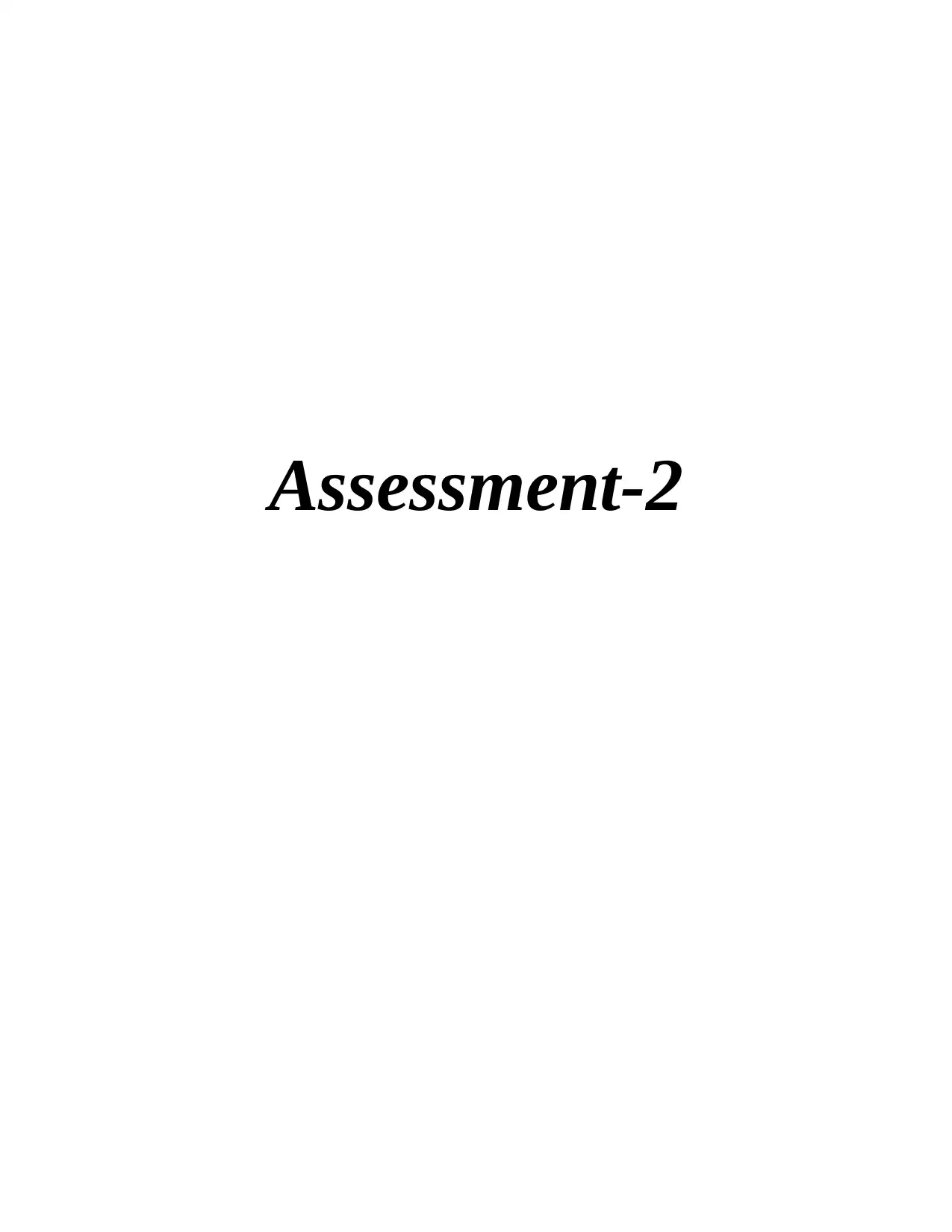
Assessment-2
Paraphrase This Document
Need a fresh take? Get an instant paraphrase of this document with our AI Paraphraser
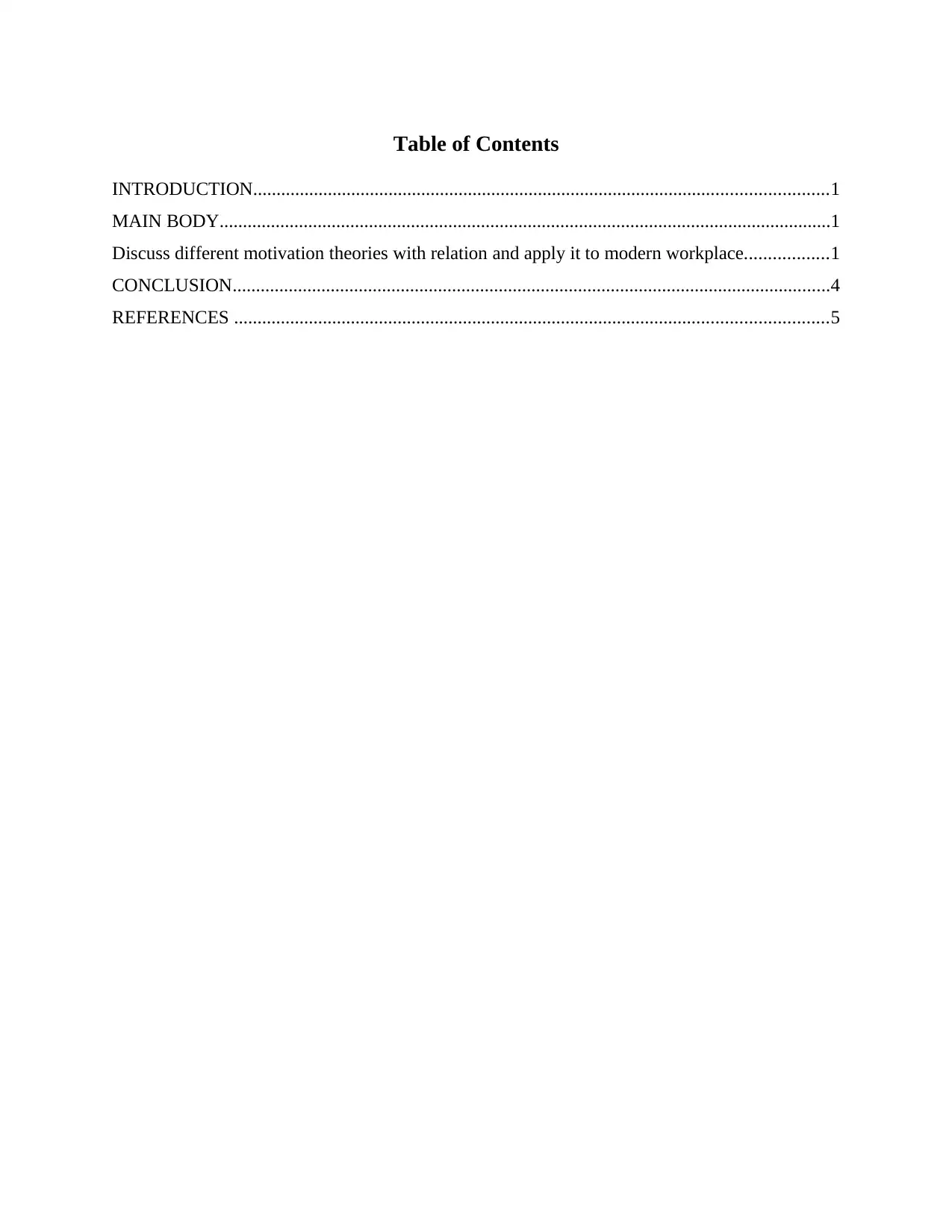
Table of Contents
INTRODUCTION...........................................................................................................................1
MAIN BODY...................................................................................................................................1
Discuss different motivation theories with relation and apply it to modern workplace..................1
CONCLUSION................................................................................................................................4
REFERENCES ...............................................................................................................................5
INTRODUCTION...........................................................................................................................1
MAIN BODY...................................................................................................................................1
Discuss different motivation theories with relation and apply it to modern workplace..................1
CONCLUSION................................................................................................................................4
REFERENCES ...............................................................................................................................5
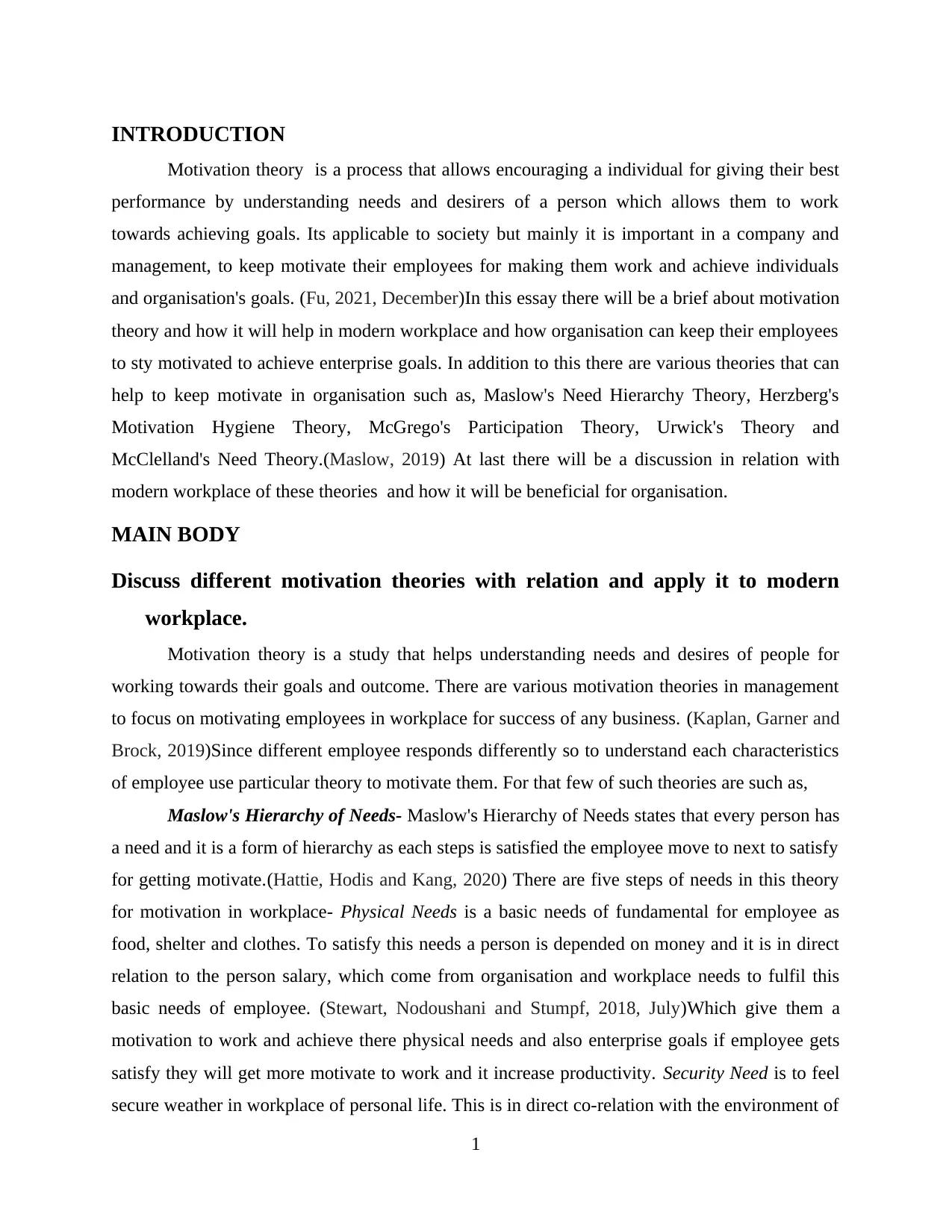
INTRODUCTION
Motivation theory is a process that allows encouraging a individual for giving their best
performance by understanding needs and desirers of a person which allows them to work
towards achieving goals. Its applicable to society but mainly it is important in a company and
management, to keep motivate their employees for making them work and achieve individuals
and organisation's goals. (Fu, 2021, December)In this essay there will be a brief about motivation
theory and how it will help in modern workplace and how organisation can keep their employees
to sty motivated to achieve enterprise goals. In addition to this there are various theories that can
help to keep motivate in organisation such as, Maslow's Need Hierarchy Theory, Herzberg's
Motivation Hygiene Theory, McGrego's Participation Theory, Urwick's Theory and
McClelland's Need Theory.(Maslow, 2019) At last there will be a discussion in relation with
modern workplace of these theories and how it will be beneficial for organisation.
MAIN BODY
Discuss different motivation theories with relation and apply it to modern
workplace.
Motivation theory is a study that helps understanding needs and desires of people for
working towards their goals and outcome. There are various motivation theories in management
to focus on motivating employees in workplace for success of any business. (Kaplan, Garner and
Brock, 2019)Since different employee responds differently so to understand each characteristics
of employee use particular theory to motivate them. For that few of such theories are such as,
Maslow's Hierarchy of Needs- Maslow's Hierarchy of Needs states that every person has
a need and it is a form of hierarchy as each steps is satisfied the employee move to next to satisfy
for getting motivate.(Hattie, Hodis and Kang, 2020) There are five steps of needs in this theory
for motivation in workplace- Physical Needs is a basic needs of fundamental for employee as
food, shelter and clothes. To satisfy this needs a person is depended on money and it is in direct
relation to the person salary, which come from organisation and workplace needs to fulfil this
basic needs of employee. (Stewart, Nodoushani and Stumpf, 2018, July)Which give them a
motivation to work and achieve there physical needs and also enterprise goals if employee gets
satisfy they will get more motivate to work and it increase productivity. Security Need is to feel
secure weather in workplace of personal life. This is in direct co-relation with the environment of
1
Motivation theory is a process that allows encouraging a individual for giving their best
performance by understanding needs and desirers of a person which allows them to work
towards achieving goals. Its applicable to society but mainly it is important in a company and
management, to keep motivate their employees for making them work and achieve individuals
and organisation's goals. (Fu, 2021, December)In this essay there will be a brief about motivation
theory and how it will help in modern workplace and how organisation can keep their employees
to sty motivated to achieve enterprise goals. In addition to this there are various theories that can
help to keep motivate in organisation such as, Maslow's Need Hierarchy Theory, Herzberg's
Motivation Hygiene Theory, McGrego's Participation Theory, Urwick's Theory and
McClelland's Need Theory.(Maslow, 2019) At last there will be a discussion in relation with
modern workplace of these theories and how it will be beneficial for organisation.
MAIN BODY
Discuss different motivation theories with relation and apply it to modern
workplace.
Motivation theory is a study that helps understanding needs and desires of people for
working towards their goals and outcome. There are various motivation theories in management
to focus on motivating employees in workplace for success of any business. (Kaplan, Garner and
Brock, 2019)Since different employee responds differently so to understand each characteristics
of employee use particular theory to motivate them. For that few of such theories are such as,
Maslow's Hierarchy of Needs- Maslow's Hierarchy of Needs states that every person has
a need and it is a form of hierarchy as each steps is satisfied the employee move to next to satisfy
for getting motivate.(Hattie, Hodis and Kang, 2020) There are five steps of needs in this theory
for motivation in workplace- Physical Needs is a basic needs of fundamental for employee as
food, shelter and clothes. To satisfy this needs a person is depended on money and it is in direct
relation to the person salary, which come from organisation and workplace needs to fulfil this
basic needs of employee. (Stewart, Nodoushani and Stumpf, 2018, July)Which give them a
motivation to work and achieve there physical needs and also enterprise goals if employee gets
satisfy they will get more motivate to work and it increase productivity. Security Need is to feel
secure weather in workplace of personal life. This is in direct co-relation with the environment of
1
⊘ This is a preview!⊘
Do you want full access?
Subscribe today to unlock all pages.

Trusted by 1+ million students worldwide
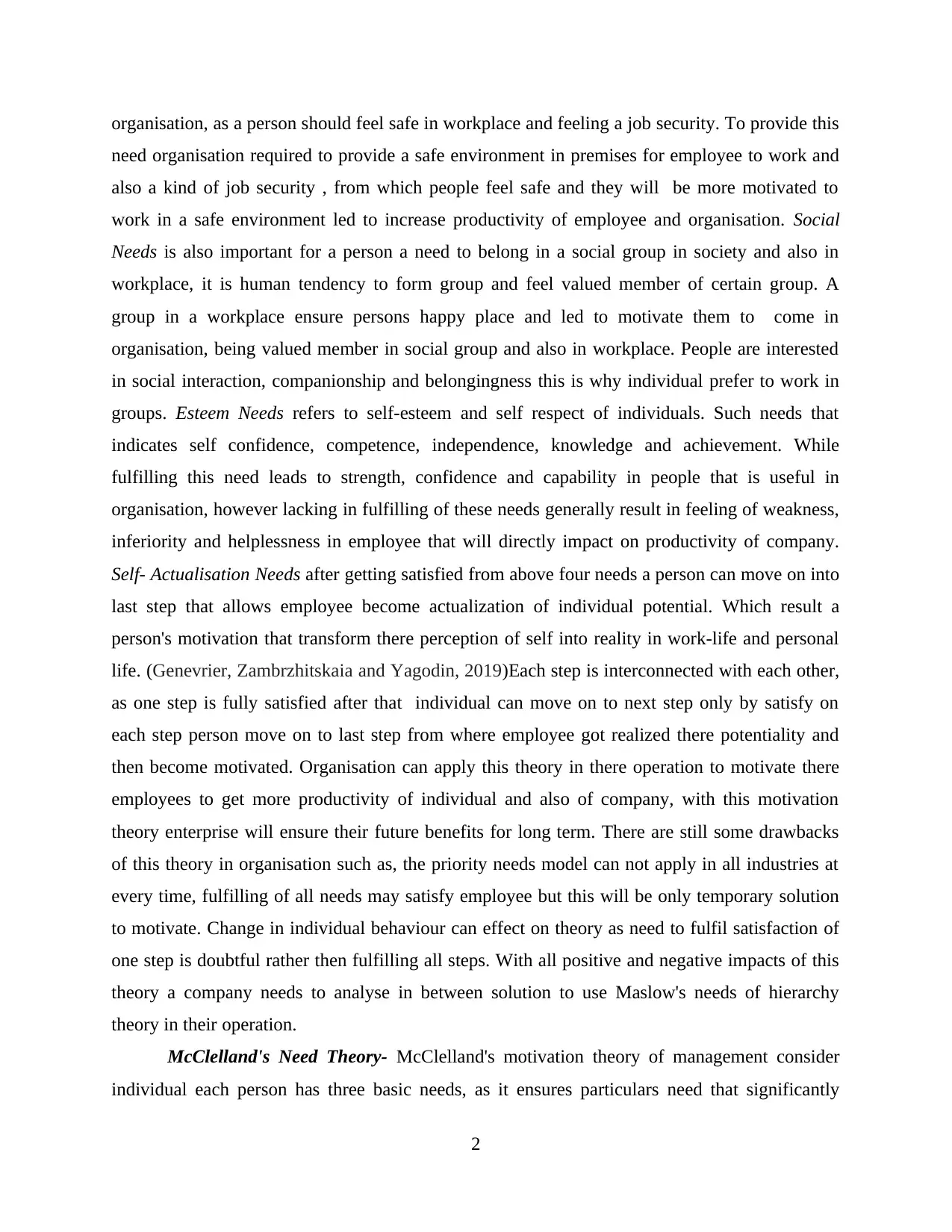
organisation, as a person should feel safe in workplace and feeling a job security. To provide this
need organisation required to provide a safe environment in premises for employee to work and
also a kind of job security , from which people feel safe and they will be more motivated to
work in a safe environment led to increase productivity of employee and organisation. Social
Needs is also important for a person a need to belong in a social group in society and also in
workplace, it is human tendency to form group and feel valued member of certain group. A
group in a workplace ensure persons happy place and led to motivate them to come in
organisation, being valued member in social group and also in workplace. People are interested
in social interaction, companionship and belongingness this is why individual prefer to work in
groups. Esteem Needs refers to self-esteem and self respect of individuals. Such needs that
indicates self confidence, competence, independence, knowledge and achievement. While
fulfilling this need leads to strength, confidence and capability in people that is useful in
organisation, however lacking in fulfilling of these needs generally result in feeling of weakness,
inferiority and helplessness in employee that will directly impact on productivity of company.
Self- Actualisation Needs after getting satisfied from above four needs a person can move on into
last step that allows employee become actualization of individual potential. Which result a
person's motivation that transform there perception of self into reality in work-life and personal
life. (Genevrier, Zambrzhitskaia and Yagodin, 2019)Each step is interconnected with each other,
as one step is fully satisfied after that individual can move on to next step only by satisfy on
each step person move on to last step from where employee got realized there potentiality and
then become motivated. Organisation can apply this theory in there operation to motivate there
employees to get more productivity of individual and also of company, with this motivation
theory enterprise will ensure their future benefits for long term. There are still some drawbacks
of this theory in organisation such as, the priority needs model can not apply in all industries at
every time, fulfilling of all needs may satisfy employee but this will be only temporary solution
to motivate. Change in individual behaviour can effect on theory as need to fulfil satisfaction of
one step is doubtful rather then fulfilling all steps. With all positive and negative impacts of this
theory a company needs to analyse in between solution to use Maslow's needs of hierarchy
theory in their operation.
McClelland's Need Theory- McClelland's motivation theory of management consider
individual each person has three basic needs, as it ensures particulars need that significantly
2
need organisation required to provide a safe environment in premises for employee to work and
also a kind of job security , from which people feel safe and they will be more motivated to
work in a safe environment led to increase productivity of employee and organisation. Social
Needs is also important for a person a need to belong in a social group in society and also in
workplace, it is human tendency to form group and feel valued member of certain group. A
group in a workplace ensure persons happy place and led to motivate them to come in
organisation, being valued member in social group and also in workplace. People are interested
in social interaction, companionship and belongingness this is why individual prefer to work in
groups. Esteem Needs refers to self-esteem and self respect of individuals. Such needs that
indicates self confidence, competence, independence, knowledge and achievement. While
fulfilling this need leads to strength, confidence and capability in people that is useful in
organisation, however lacking in fulfilling of these needs generally result in feeling of weakness,
inferiority and helplessness in employee that will directly impact on productivity of company.
Self- Actualisation Needs after getting satisfied from above four needs a person can move on into
last step that allows employee become actualization of individual potential. Which result a
person's motivation that transform there perception of self into reality in work-life and personal
life. (Genevrier, Zambrzhitskaia and Yagodin, 2019)Each step is interconnected with each other,
as one step is fully satisfied after that individual can move on to next step only by satisfy on
each step person move on to last step from where employee got realized there potentiality and
then become motivated. Organisation can apply this theory in there operation to motivate there
employees to get more productivity of individual and also of company, with this motivation
theory enterprise will ensure their future benefits for long term. There are still some drawbacks
of this theory in organisation such as, the priority needs model can not apply in all industries at
every time, fulfilling of all needs may satisfy employee but this will be only temporary solution
to motivate. Change in individual behaviour can effect on theory as need to fulfil satisfaction of
one step is doubtful rather then fulfilling all steps. With all positive and negative impacts of this
theory a company needs to analyse in between solution to use Maslow's needs of hierarchy
theory in their operation.
McClelland's Need Theory- McClelland's motivation theory of management consider
individual each person has three basic needs, as it ensures particulars need that significantly
2
Paraphrase This Document
Need a fresh take? Get an instant paraphrase of this document with our AI Paraphraser
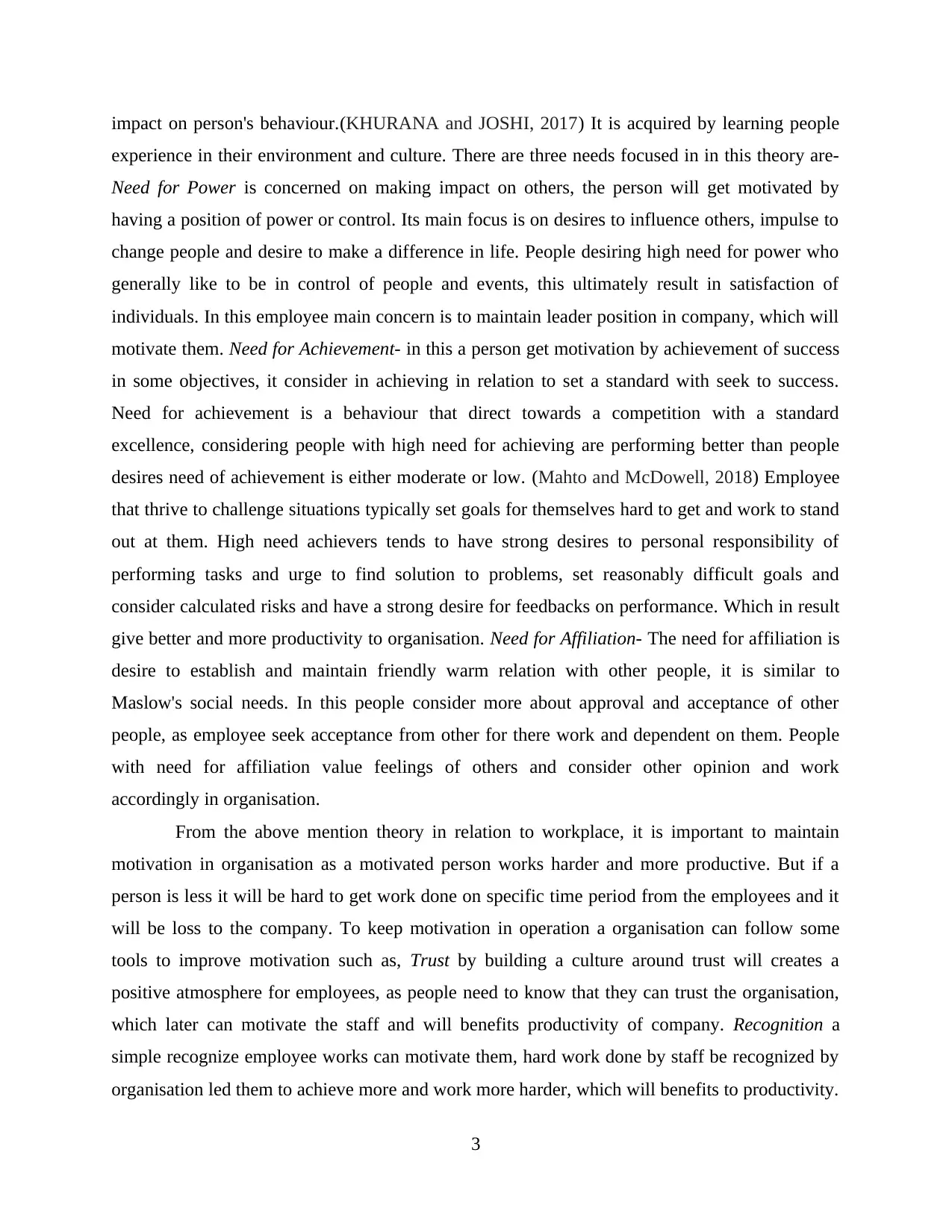
impact on person's behaviour.(KHURANA and JOSHI, 2017) It is acquired by learning people
experience in their environment and culture. There are three needs focused in in this theory are-
Need for Power is concerned on making impact on others, the person will get motivated by
having a position of power or control. Its main focus is on desires to influence others, impulse to
change people and desire to make a difference in life. People desiring high need for power who
generally like to be in control of people and events, this ultimately result in satisfaction of
individuals. In this employee main concern is to maintain leader position in company, which will
motivate them. Need for Achievement- in this a person get motivation by achievement of success
in some objectives, it consider in achieving in relation to set a standard with seek to success.
Need for achievement is a behaviour that direct towards a competition with a standard
excellence, considering people with high need for achieving are performing better than people
desires need of achievement is either moderate or low. (Mahto and McDowell, 2018) Employee
that thrive to challenge situations typically set goals for themselves hard to get and work to stand
out at them. High need achievers tends to have strong desires to personal responsibility of
performing tasks and urge to find solution to problems, set reasonably difficult goals and
consider calculated risks and have a strong desire for feedbacks on performance. Which in result
give better and more productivity to organisation. Need for Affiliation- The need for affiliation is
desire to establish and maintain friendly warm relation with other people, it is similar to
Maslow's social needs. In this people consider more about approval and acceptance of other
people, as employee seek acceptance from other for there work and dependent on them. People
with need for affiliation value feelings of others and consider other opinion and work
accordingly in organisation.
From the above mention theory in relation to workplace, it is important to maintain
motivation in organisation as a motivated person works harder and more productive. But if a
person is less it will be hard to get work done on specific time period from the employees and it
will be loss to the company. To keep motivation in operation a organisation can follow some
tools to improve motivation such as, Trust by building a culture around trust will creates a
positive atmosphere for employees, as people need to know that they can trust the organisation,
which later can motivate the staff and will benefits productivity of company. Recognition a
simple recognize employee works can motivate them, hard work done by staff be recognized by
organisation led them to achieve more and work more harder, which will benefits to productivity.
3
experience in their environment and culture. There are three needs focused in in this theory are-
Need for Power is concerned on making impact on others, the person will get motivated by
having a position of power or control. Its main focus is on desires to influence others, impulse to
change people and desire to make a difference in life. People desiring high need for power who
generally like to be in control of people and events, this ultimately result in satisfaction of
individuals. In this employee main concern is to maintain leader position in company, which will
motivate them. Need for Achievement- in this a person get motivation by achievement of success
in some objectives, it consider in achieving in relation to set a standard with seek to success.
Need for achievement is a behaviour that direct towards a competition with a standard
excellence, considering people with high need for achieving are performing better than people
desires need of achievement is either moderate or low. (Mahto and McDowell, 2018) Employee
that thrive to challenge situations typically set goals for themselves hard to get and work to stand
out at them. High need achievers tends to have strong desires to personal responsibility of
performing tasks and urge to find solution to problems, set reasonably difficult goals and
consider calculated risks and have a strong desire for feedbacks on performance. Which in result
give better and more productivity to organisation. Need for Affiliation- The need for affiliation is
desire to establish and maintain friendly warm relation with other people, it is similar to
Maslow's social needs. In this people consider more about approval and acceptance of other
people, as employee seek acceptance from other for there work and dependent on them. People
with need for affiliation value feelings of others and consider other opinion and work
accordingly in organisation.
From the above mention theory in relation to workplace, it is important to maintain
motivation in organisation as a motivated person works harder and more productive. But if a
person is less it will be hard to get work done on specific time period from the employees and it
will be loss to the company. To keep motivation in operation a organisation can follow some
tools to improve motivation such as, Trust by building a culture around trust will creates a
positive atmosphere for employees, as people need to know that they can trust the organisation,
which later can motivate the staff and will benefits productivity of company. Recognition a
simple recognize employee works can motivate them, hard work done by staff be recognized by
organisation led them to achieve more and work more harder, which will benefits to productivity.
3
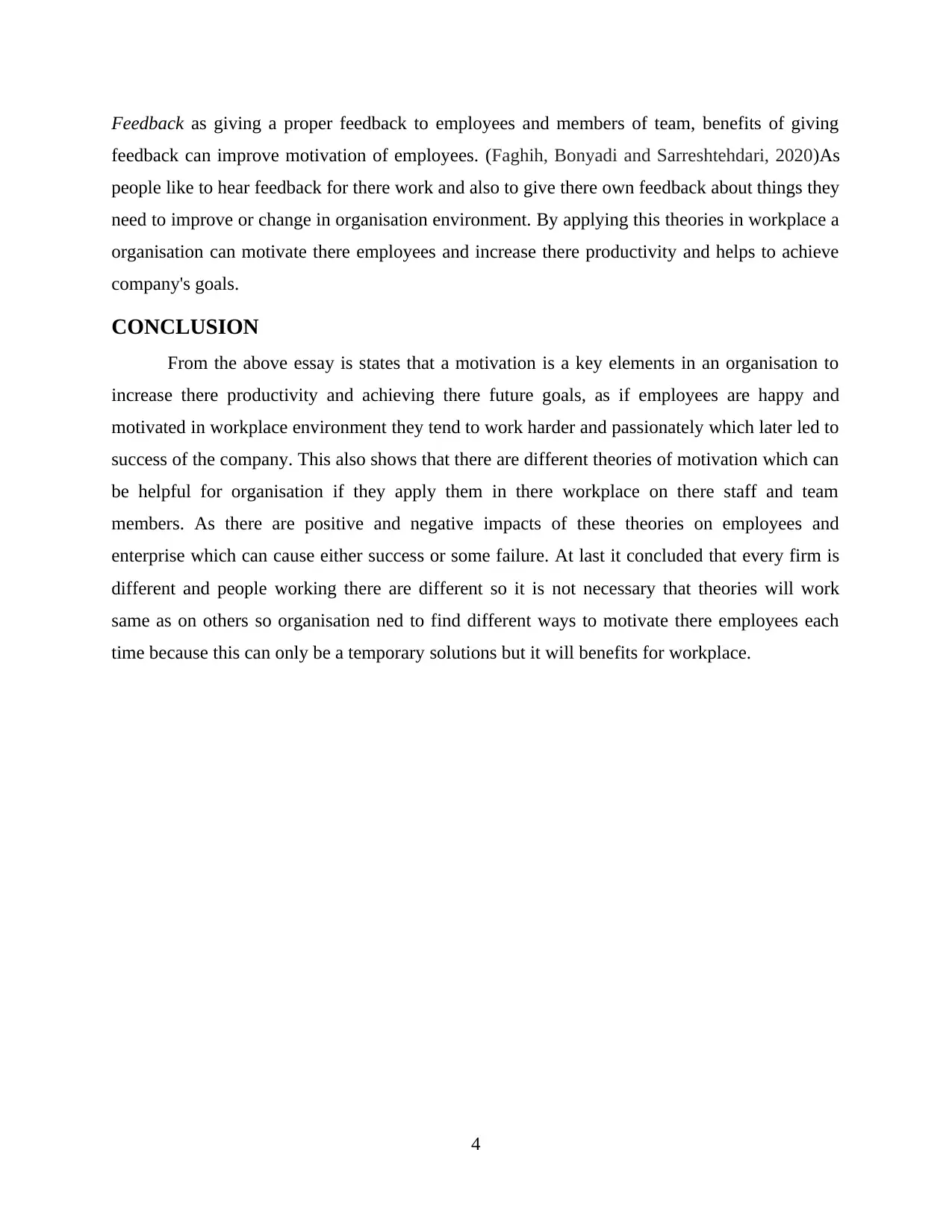
Feedback as giving a proper feedback to employees and members of team, benefits of giving
feedback can improve motivation of employees. (Faghih, Bonyadi and Sarreshtehdari, 2020)As
people like to hear feedback for there work and also to give there own feedback about things they
need to improve or change in organisation environment. By applying this theories in workplace a
organisation can motivate there employees and increase there productivity and helps to achieve
company's goals.
CONCLUSION
From the above essay is states that a motivation is a key elements in an organisation to
increase there productivity and achieving there future goals, as if employees are happy and
motivated in workplace environment they tend to work harder and passionately which later led to
success of the company. This also shows that there are different theories of motivation which can
be helpful for organisation if they apply them in there workplace on there staff and team
members. As there are positive and negative impacts of these theories on employees and
enterprise which can cause either success or some failure. At last it concluded that every firm is
different and people working there are different so it is not necessary that theories will work
same as on others so organisation ned to find different ways to motivate there employees each
time because this can only be a temporary solutions but it will benefits for workplace.
4
feedback can improve motivation of employees. (Faghih, Bonyadi and Sarreshtehdari, 2020)As
people like to hear feedback for there work and also to give there own feedback about things they
need to improve or change in organisation environment. By applying this theories in workplace a
organisation can motivate there employees and increase there productivity and helps to achieve
company's goals.
CONCLUSION
From the above essay is states that a motivation is a key elements in an organisation to
increase there productivity and achieving there future goals, as if employees are happy and
motivated in workplace environment they tend to work harder and passionately which later led to
success of the company. This also shows that there are different theories of motivation which can
be helpful for organisation if they apply them in there workplace on there staff and team
members. As there are positive and negative impacts of these theories on employees and
enterprise which can cause either success or some failure. At last it concluded that every firm is
different and people working there are different so it is not necessary that theories will work
same as on others so organisation ned to find different ways to motivate there employees each
time because this can only be a temporary solutions but it will benefits for workplace.
4
⊘ This is a preview!⊘
Do you want full access?
Subscribe today to unlock all pages.

Trusted by 1+ million students worldwide
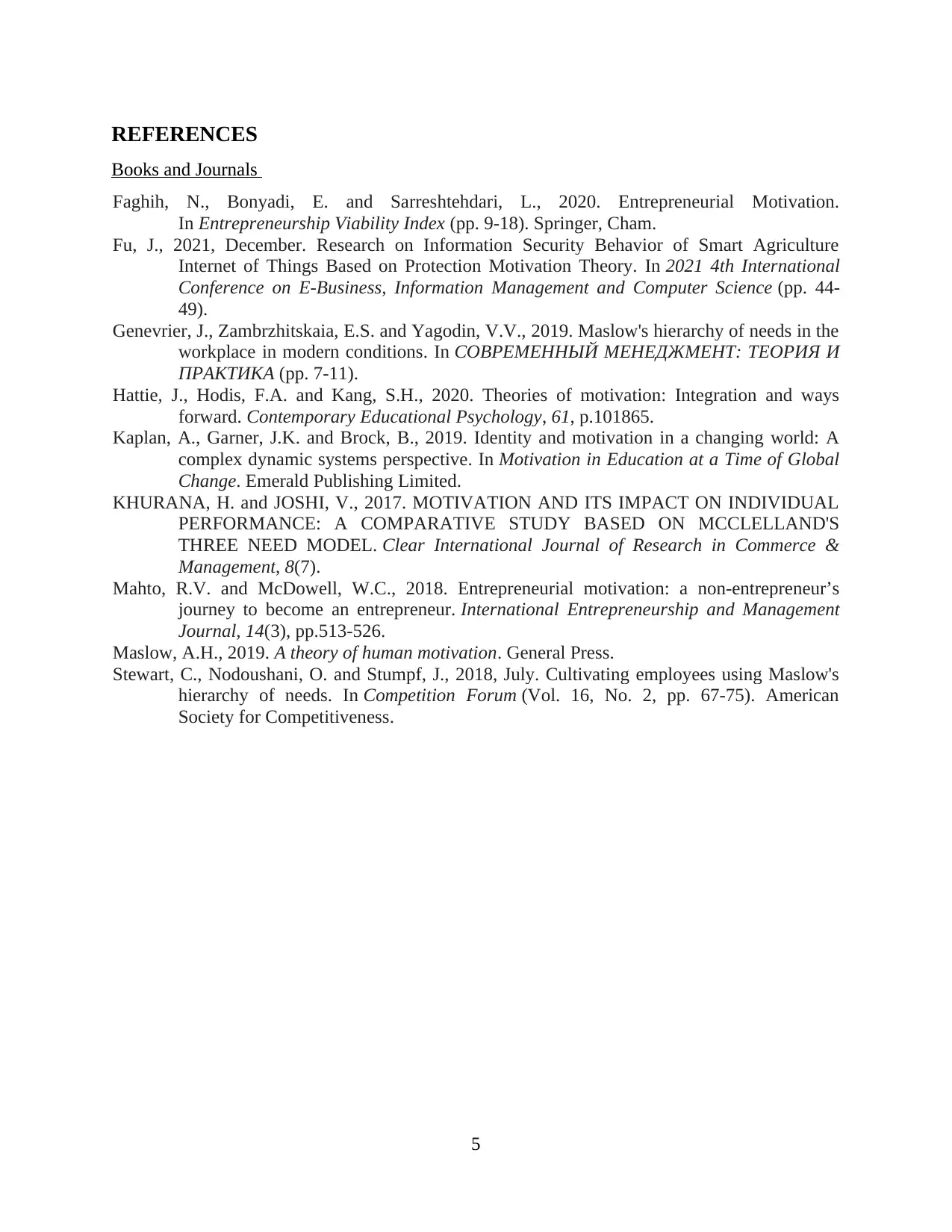
REFERENCES
Books and Journals
Faghih, N., Bonyadi, E. and Sarreshtehdari, L., 2020. Entrepreneurial Motivation.
In Entrepreneurship Viability Index (pp. 9-18). Springer, Cham.
Fu, J., 2021, December. Research on Information Security Behavior of Smart Agriculture
Internet of Things Based on Protection Motivation Theory. In 2021 4th International
Conference on E-Business, Information Management and Computer Science (pp. 44-
49).
Genevrier, J., Zambrzhitskaia, E.S. and Yagodin, V.V., 2019. Maslow's hierarchy of needs in the
workplace in modern conditions. In СОВРЕМЕННЫЙ МЕНЕДЖМЕНТ: ТЕОРИЯ И
ПРАКТИКА (pp. 7-11).
Hattie, J., Hodis, F.A. and Kang, S.H., 2020. Theories of motivation: Integration and ways
forward. Contemporary Educational Psychology, 61, p.101865.
Kaplan, A., Garner, J.K. and Brock, B., 2019. Identity and motivation in a changing world: A
complex dynamic systems perspective. In Motivation in Education at a Time of Global
Change. Emerald Publishing Limited.
KHURANA, H. and JOSHI, V., 2017. MOTIVATION AND ITS IMPACT ON INDIVIDUAL
PERFORMANCE: A COMPARATIVE STUDY BASED ON MCCLELLAND'S
THREE NEED MODEL. Clear International Journal of Research in Commerce &
Management, 8(7).
Mahto, R.V. and McDowell, W.C., 2018. Entrepreneurial motivation: a non-entrepreneur’s
journey to become an entrepreneur. International Entrepreneurship and Management
Journal, 14(3), pp.513-526.
Maslow, A.H., 2019. A theory of human motivation. General Press.
Stewart, C., Nodoushani, O. and Stumpf, J., 2018, July. Cultivating employees using Maslow's
hierarchy of needs. In Competition Forum (Vol. 16, No. 2, pp. 67-75). American
Society for Competitiveness.
5
Books and Journals
Faghih, N., Bonyadi, E. and Sarreshtehdari, L., 2020. Entrepreneurial Motivation.
In Entrepreneurship Viability Index (pp. 9-18). Springer, Cham.
Fu, J., 2021, December. Research on Information Security Behavior of Smart Agriculture
Internet of Things Based on Protection Motivation Theory. In 2021 4th International
Conference on E-Business, Information Management and Computer Science (pp. 44-
49).
Genevrier, J., Zambrzhitskaia, E.S. and Yagodin, V.V., 2019. Maslow's hierarchy of needs in the
workplace in modern conditions. In СОВРЕМЕННЫЙ МЕНЕДЖМЕНТ: ТЕОРИЯ И
ПРАКТИКА (pp. 7-11).
Hattie, J., Hodis, F.A. and Kang, S.H., 2020. Theories of motivation: Integration and ways
forward. Contemporary Educational Psychology, 61, p.101865.
Kaplan, A., Garner, J.K. and Brock, B., 2019. Identity and motivation in a changing world: A
complex dynamic systems perspective. In Motivation in Education at a Time of Global
Change. Emerald Publishing Limited.
KHURANA, H. and JOSHI, V., 2017. MOTIVATION AND ITS IMPACT ON INDIVIDUAL
PERFORMANCE: A COMPARATIVE STUDY BASED ON MCCLELLAND'S
THREE NEED MODEL. Clear International Journal of Research in Commerce &
Management, 8(7).
Mahto, R.V. and McDowell, W.C., 2018. Entrepreneurial motivation: a non-entrepreneur’s
journey to become an entrepreneur. International Entrepreneurship and Management
Journal, 14(3), pp.513-526.
Maslow, A.H., 2019. A theory of human motivation. General Press.
Stewart, C., Nodoushani, O. and Stumpf, J., 2018, July. Cultivating employees using Maslow's
hierarchy of needs. In Competition Forum (Vol. 16, No. 2, pp. 67-75). American
Society for Competitiveness.
5
1 out of 7
Related Documents
Your All-in-One AI-Powered Toolkit for Academic Success.
+13062052269
info@desklib.com
Available 24*7 on WhatsApp / Email
![[object Object]](/_next/static/media/star-bottom.7253800d.svg)
Unlock your academic potential
Copyright © 2020–2025 A2Z Services. All Rights Reserved. Developed and managed by ZUCOL.


